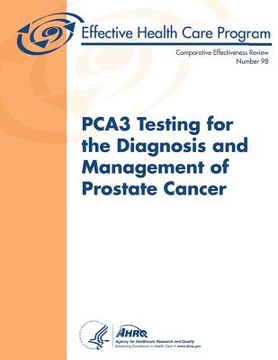PCA3 Testing for the Diagnosis and Management of Prostate Cancer: Comparative Effectiveness Review Number 98 (en Inglés)
Reseña del libro "PCA3 Testing for the Diagnosis and Management of Prostate Cancer: Comparative Effectiveness Review Number 98 (en Inglés)"
Cancer of the prostate is the second most common cancer and the second leading cause of cancer deaths in men in the U.S. A challenge in managing clinically localized disease is distinguishing between men who have aggressive disease and need immediate therapy, and those who have less aggressive disease that can be safely managed by active surveillance. Production of serum total prostate specific antigen (tPSA) was found to be increased in men with prostate cancer as many as 5 to 10 years prior to symptoms of clinical disease. The rationale for initiating prostate cancer screening using tPSA was to reduce the prevalence of advanced prostate cancer and prostate cancer-related mortality through early detection, and improve quality of life. Prostate cancer mortality has decreased, but at what cost in over diagnosis and potential harms related to treatment? Also, issues such as who to test, when to test and retest, and the most effective clinical tPSA threshold continue to be debated. A recent U.S. Preventive Services Task Force recommendation concluded that the potential benefits do not outweigh the harms. However, the balance of benefits and harms of tPSA screening remains controversial. In 1999, researchers reported that the prostate cancer antigen 3 gene (PCA3; also known as DD3), was highly overexpressed in prostate cancer relative to normal prostate or benign prostatic hyperplasia tissue. Subsequently, PCA3 tests on messenger RNA from urine were developed. Two proposed intended uses of PCA3 and comparator tests were to inform decisionmaking about initial or repeat biopsy of men with elevated tPSA and/or other risk factors. The third was to inform decisions about management and treatment (e.g., active surveillance, prostatectomy, radiotherapy) by classifying disease in men with positive biopsies as insignificant or aggressive. The U.S. Food and Drug Administration (FDA) recently approved a PCA3 assay for use in men 50 years of age or older who have had one or more previous negative biopsies, but did not have a finding of atypical small acinar proliferation in the most recent biopsy. The intended use of the test is to inform decision making about repeat biopsy. For risk classification, PCA3 comparators in a prognostic workup include Gleason score, prostate volume, risk factors, biochemical markers, and clinical/pathological staging. The Key Questions addressed include: KQ1: In patients with elevated PSA and/or an abnormal digital rectal examination who are candidates for initial prostate biopsy, what is the comparative effectiveness of PCA3 testing as a replacement for, or supplement to, standard tests, including diagnostic accuracy for prostate cancer, intermediate outcomes, and long-term health outcomes, including mortality/morbidity, quality of life, and potential harms? KQ 2: In patients with elevated PSA and/or an abnormal digital rectal examination who are candidates for repeat prostate biopsy, what is the comparative effectiveness of PCA3 testing as a replacement for, or supplement to, standard tests, including diagnostic accuracy for prostate cancer, intermediate outcomes, and long-term health outcomes, including mortality/morbidity, quality of life, and potential harms? KQ 3: In patients with a positive biopsy for prostate cancer who are being evaluated to distinguish between insignificant/indolent and aggressive disease, what is the effectiveness of using PCA3 testing alone, or in combination with the standard prognostic workup (e.g., tumor volume, Gleason score, clinical staging) or monitoring tests (e.g., PSA, PSA velocity), with regard to diagnostic accuracy for aggressive (high-risk) prostate cancer, intermediate outcomes, and long-term health outcomes, including mortality/morbidity, quality of life, and potential harms?

